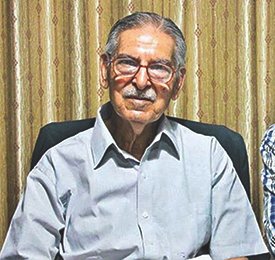“Govt has been tardy in spending on health�
March 07, 2015 | Saturday | Interviews | By Rahul Koul Koul
“Govt has been tardy in spending on health�
Padma Shree Dr Nitya Anand, legendary scientist & chairman, Ranbaxy Science Foundation
Q: Please tell us about the current efforts for the eradication of Leprosy from the country?
When I joined the Central Drug Research Institute (CDRI), Lucknow way back in 1950, I started working on Dapsone as it was coming out as a promising drug. We started making its analogs and improved key activities. However, the pharmacoeconomics which was the comparison with available therapy couldn't be approved. We worked on the design and synthesis of sulphones and sulphonamides for leprosy. We tried to understand crucial factors in drug design such as transport across membranes, biology of the parasite and pathology of the disease through a multidisciplinary approach.
The drug development studies of the candidate molecules included a study of their absorption, metabolism and distribution even at that early stage. Diaminodiphenyl sulfone (DDS) was very cheap and easy to use. We also had a drug that was made active but it was not cheaper than DDS which had favourable pharmacoeconomics.
Q: Has there been any change in the social stigma attached with Leprosy?
The social stigma still exists but at a very low scale. In 1983, as a member of the then Prime Minister's committee for health, I remember that even patients had to take special permission to travel. Finally after hectic efforts, it was changed and the discrimination removed. However, in rural areas, they are treated as outcasts. Like any other disease, they have to be treated and we have to build awareness on the subject.
Q: What has been the recent research for treatment of this disease?
With a multidrug treatment (MDT), what they call, Dapsone as a basic drug can be combined with others such as rifampicine and clofazimine, ninety nine percent of cases can be treated. This is a part of the government program and available for free. Dapsone has less resistance and has been the effective treatment whose use within a MDT can help eradicate the disease.
Q: Has there been any national mission to tackle the disease? What is required?
There indeed was a mission in place in year 2000 and was extended up to year 2005 later as the targets were not completed. Now, it is the duty of the government to rework on it and complete it with new targets. There is no mention of it in the national health policy draft. It must be included as well.
Diagnosis is not easy and there is requirement of well-trained people who have trained hands for treating leprosy. When it becomes a part of the mission program, specific efforts unfortunately are watered down. Lack of efforts in diagnostics for Leprosy need to be taken care of.
Q: Which disease areas according to you must be prioritized?
The diseases that require attention are Malaria, Tuberculosis, and Leprosy in infectious disease category.
Leprosy drugs are available with the government machinery and awareness has to be built in a large scale. Very serious research work has been done on malarial vaccines. But the results are yet to be seen on ground. It is a very serious concern. In tuberculosis, resistance is a big problem. They have drugs but the development of resistance is an issue. Today in India, there is growing resistance as we have not taken care at the appropriate time. There are varieties which are not responding to available drugs and are thus much more infectious. If a vaccine could be developed at an appropriate time, virulence could be stopped.
Q: What is required by the government on the lesser health spending?
Government is very tardy in spending on education and health. I can say that without any question as these two areas have been ignored repeatedly. There could have been much more done for these areas but unfortunately despite marketing of policies by the respective governments, there has been much less happening actually. At least, there can be 2 to 3 percent of GDP spending for actual results to come. That would be far lesser but could make a difference.










